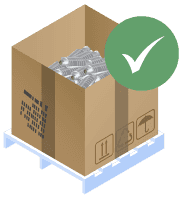Processing Knowledge
An Overview of the Catalytic Converter Recycling Industry

The catalytic converter was invented after the rise of automobile production led to increased pollutants in our air. Catalytic converters were designed to transform harmful gasses into less toxic emissions, and they've been a staple in all cars since the 1970s. That means that the converter recycling industry has been around for roughly 50 years, and we’re here to give you all the details. Check out our video or keep reading to get informed.
What Is A Catalytic Converter?
A converter is an emission control device installed on gasoline, diesel, and hybrid vehicles to reduce harmful pollutants. It works through a process called oxidation and transforms carbon monoxide, hydrocarbons, and nitrogen oxides into carbon dioxide, nitrogen, oxygen, and water vapor. This process can only be achieved with a catalyst made of platinum, palladium, and rhodium.
Historically, vehicles had one large converter, but as technology progressed, manufacturers switched the large unit for multiple smaller ones. This meant that there were lower average recoverable ounces of platinum, palladium, and rhodium. Today, carmakers install one or multiple converters in a vehicle.
Oxygen Sensors
Oxygen sensors are an additional component of the catalytic converter that also contain precious metals. They’re used to ensure the converter is functioning properly. There are typically anywhere between 2 – 4 oxygen sensors on a converter and are located both upstream and downstream of the unit.
Why are Converters Valuable?
As we’ve mentioned above, the inside of a converter is made with platinum, palladium, and rhodium. These precious metals are essential to the global supply chain, and they play key roles in the production of jewelry, electronics, glass, pharmaceuticals, green energy, and more.
The demand for these metals has risen steadily over the decades, meaning that the market value has also increased. With the green transition, hydrogen fuel cells, solar power, and more ecologically friendly solutions emerging, the demand for these metals will only continue to skyrocket.
While converters are valuable because of the precious metals they contain, it’s important to note that not all converters contain the same amount of metals. Let’s dive a little deeper into this.
Factors That Affect Metal Content in Converters
Factors that impact a converter’s precious metal concentration include emission policies, a vehicle’s wear and tear, and converter dismantling. That’s why every converter is valued differently once it enters the recycling stream.
Emission Policies
The stricter the emission policies in a country or state, the higher the required metal loadings in a converter. For example, California has strict emission policies, which means all vehicles sold in California must have converters with higher precious metal loadings.
It’s important to note here that emission laws are changing and getting stricter and stricter. More than 16 other American states have adopted the California emission standards. The remaining states follow the EPA’s Tier 3 rules, implemented in 2017. This means that as emission standards get stricter and more states adopt unified standards, we’ll be seeing fewer discrepancies in the metal content loaded in converters during manufacturing. But since the average lifespan of a vehicle is around 12 years, we’ll only start to see these changes in precious metal loadings in 2030.
Vehicle Wear and Tear
The precious metal loadings of a converter will be affected by the general treatment of the vehicle. One factor that affects a converter’s ceramic content is a lack of maintenance, which could in turn affect the precious metal loadings. That’s why regular check-ups and vehicle care is strongly encouraged.
Having a higher mileage can also result in lower metal content, and vehicles that have been in accidents tend to have decreased precious metal loadings. If a converter was cut, hit, or disturbed in any way, this can also result in lower metal content.
Converter Dismantling
During the dismantling process, if a converter is torn, ripped, or otherwise improperly removed from the vehicle, this can result in ceramic loss and reduce the metal content in the converter. That’s why it’s important for vehicle dismantlers and recyclers to use proper dismantling methods.
Now that we know what factors affect precious metal content in converters, we can take a look at the first step of the recycling process: acquisition. Where do scrap converters come from and how can you buy them?
Converter Acquisition
For automotive recyclers, converters are a byproduct of their end-of-life vehicle purchases, which can be an added revenue stream. On the other hand, scrap metal recyclers buy individual units at scale and resell them to other buyers or to a processor. A business can collect converters using both these methods.
Recyclers either sell to other buyers for a per unit price or deal directly with a company that can offer payment based on ceramic weight and precious metal loadings at current market price, like a toll-refiner.
Purchasing converters on a per unit basis means evaluating them by grading categories and/or serial numbers. It’s important to remember that both methods can vary based on the buyer, because buyers don’t have the same pricing information and don’t always have access to accurate evaluation tools.
What to Look Out for When Evaluating Converters by Serial Numbers
While evaluating a converter by serial number can be predictive of its true value, there are two factors to consider. First, if a buyer doesn’t have reliable and accurate pricing information, recyclers won’t be getting a fair price. It’s crucial to evaluate if a buyer/seller has the right pricing data.
Second, converters are old and dirty, meaning that corrosion will affect the visibility of serial numbers. The only way for recyclers to assess their material’s true value is to sell directly to a toll-refiner, which brings us to converter processing.
Catalytic Converter Processing
Once the converters have been sold to a toll-refiner, the units undergo multiple stages of processing. The converters are decanned, crushed, commingled, sampled, and then sent for laboratory analysis. Recyclers are paid based on that laboratory analysis, which determines the amount of each precious metal found in their converters. Let’s take a closer look at this process.
The Most Important Step: Assay
Traditionally, recyclers had to have a minimum of 2,000 lbs of ceramic to work with a company that provided payment based on laboratory analysis. Today, PMR has developed specialized machinery that allows suppliers with a minimum of 200 lbs of ceramic to deal directly with us.
Once the converters have been crushed and commingled, they get sampled and sent to a lab for an assay analysis. Toll-refiners use two primary technologies to evaluate catalyst material: X-ray Fluorescence (XRF) benchtop and Inductive Coupled Plasma (ICP) devices. These machines will determine the concentration of platinum, palladium, and rhodium in a recycler’s entire load.
Once the analysis is complete, recyclers receive their troy ounce recovery figures, which helps them hedge market prices for platinum, palladium, and rhodium. That allows them to request payment and remain confident that they’re getting paid based on their material’s true value.
While this is the end of the line for recyclers, their converters still have a long way to go before they re-enter the global supply chain.
What Happens After the Toll-Refiner?
Once the laboratory analysis is complete, the ounces move to the smelting stage, which involves an arc-furnace that heats and melts the ceramic. This is where the extraction process begins.
The metals that are separated from the ceramic are again reduced. They undergo chemical leaching and separation, further concentrating the material into a metal sponge or its pure elemental state. It’s at this point that the metals are considered physical ounces available for purchase, sale, and trade.
The sponge can be sold back into the metal market or can undergo further heat treatments, where the sponge is melted to produce pure metal bullion bars. The metal bars are stored and shipped to and from bullion vaults, otherwise known as depositories. When the metal sponges and bullion bars are resold, platinum, palladium, and rhodium return to the global supply chain.
But this wouldn’t be a complete converter recycling overview without explaining how the precious metal market comes into play.
The Precious Metal Market and How It Affects Converter Value
As we’ve mentioned before, the value of a converter depends on the market prices of platinum, palladium, and rhodium. However, the market changes all the time, which can be a little confusing. We’re here to explain how the market changes and why it affects the value of catalyst material.
Platinum & Palladium
As platinum and palladium are traded daily on the open market, there are multiple purchasers of these metals. End-buyers for these come from various industries, including vehicle production, the medical and pharmaceutical fields, clean energy production, and more.
This means that prices fluctuate according to supply, demand, and speculation. While these metals are crucial for catalytic converter manufacturing, they have a wide range of other uses including medical tools and applications, electrical manufacturing, and jewelry. Prices for these two metals can vary every minute.
Rhodium
Rhodium is among the hardest metals to mine, which means it’s only bought and sold for industrial commercial uses, including to reduce greenhouse gas emissions. Around 80% of recycled rhodium goes back into the production of converters, which means end-buyers for rhodium are mostly large car manufacturing companies. It’s for this reason that rhodium isn’t a commodity traded on the open market. Rhodium’s market price changes every 24 hours.
While you may think that converters have a fixed price, their value changes all the time. As we’ve seen, it’s because the market for the precious metal they contain varies daily or even by the minute.
PMR: A Pioneer in the Converter Processing Industry
As a converter processor that got its start in 1996, we’ve been helping recyclers unlock their material’s true value for more than a quarter of a century. When recyclers choose PMR, they choose to benefit from our expert advice and support throughout the processing journey. From purchasing converters all the way through to the final sale of their metals, they’ve got an ally in their corner.
We’ve developed innovative processing systems and redefined the toll-refining process through cutting-edge machinery and top-tier processes. We’ve launched user-friendly pricing and referencing tools, such as photo grading and VIN/TRIM. Our suppliers have access to tracking and inventory tools through their exclusive Supplier Services Platform (SSP). Our top-quality services reflect our belief that informed recyclers make the best choices for their businesses.
For more information, visit PMR’s Resource Center.

